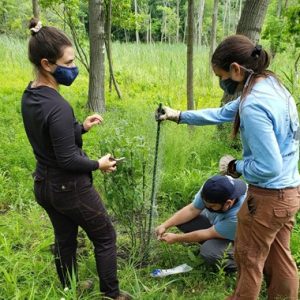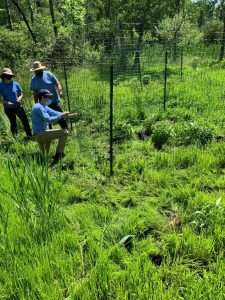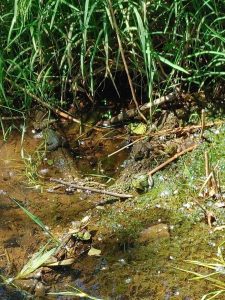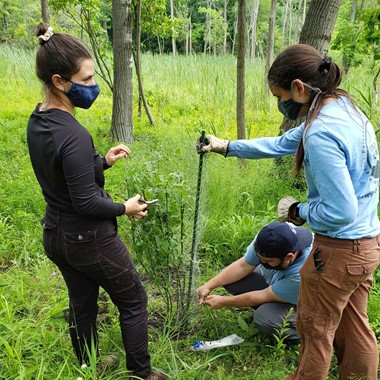By Jason Kappan, Invasive Species Management Assistant.
Reinstein Woods Nature Preserve, a complex of forests, wetlands and ponds, is a special place to enjoy nature and wildlife. The 292-acre preserve had limited access until 2001 when it opened to the public and has since offered a variety of opportunities to explore and learn about natural areas. The staff and volunteers at Reinstein Woods have been managing an invasive species, common reed (Phragmites australis), for a few years. WNY PRISM partnered with Reinstein Woods to help with Phragmites removal and aid in restoration by planting native species in the preserve. To deter grazing animals and ensure native plants have time to establish, WNY PRISM Crew built deer exclosures around newly planted species. Native flora planted by the Crew consisted of Virginia mountain mint (Pycnanthemum virginianum), boneset (Eupatorium Perfoliatum), big bluestem (Andropogon gerardii), monkey flower (Mimulus ringens), Joe Pye weed (Eutrochium purpureum), swamp milkweed (Asclepias incarnata), silky dogwood (Cornus amomum), buttonbush (Cephalanthus occidentalis) and nannyberry (Viburnum lentago).

The Crew planting native plants in an area where Phragmites has been managed.
The area of interest in Reinstein Woods is an infestation of Phragmites that becomes a monoculture at the end of a trail. Once the infestation is treated, it will become an educational area to demonstrate the success of the restoration project. The Crew planted native species at the sparser area where the Reinstein Woods staff has been managing Phragmites for a few years. First, the Crew planted inside some deer exclosures that had been partially constructed by volunteers. Then the Crew finished building the deer exclosures and constructed some additional ones.
Deer exclosures were made of chicken wire and metal t-posts, which is a simple but effective way to make sure deer and other grazers could not enter the native planting areas. At the request of Reinstein Woods staff, the Crew constructed doors for the exclosures, so people can access the interior if needed. It was a fun challenge to figure out how to make an opening in the chicken wire but still be able to close it to effectively keep animals out. It all came down to zip tying it shut.

The crew working on deer exclosure barriers.

Creating a doorway in the deer exclosure for access.
While performing this restoration work the Crew observed many interesting wildlife and plants. During a water break the Crew noticed an army of leopard frogs (Lithobates spp.) sitting together on a small branch in the tiny creek next to them in the shade. A red-bellied woodpecker (Melanerpes carolinus) was near the Crew the whole week of the project and greeted them every morning. On the second day, Baltimore orioles (Icterus galbula) were spotted across from where the Crew was planting. Two interesting plants were spotted in the area that some that the Crew had not seen before. They were bluejacket (Tradescantia ohiensis) and blue water speedwell (Veronica anagallis–aquatica).

Four leopard frogs in the stream.
The Reinstein Woods staff worked alongside the Crew to help with planting, and even brought out a jug of ice-cold water during the hot and humid weather. All materials needed to complete the project were brought out to the Crew by the staff members and this made the work fast and effective to complete. The work was completed ahead of schedule, and the Crew was able to add more barriers and native flora than originally planned. Now, the only part of the project left is to help the Reinstein Woods staff manage the Phragmites infestation later in the summer.


